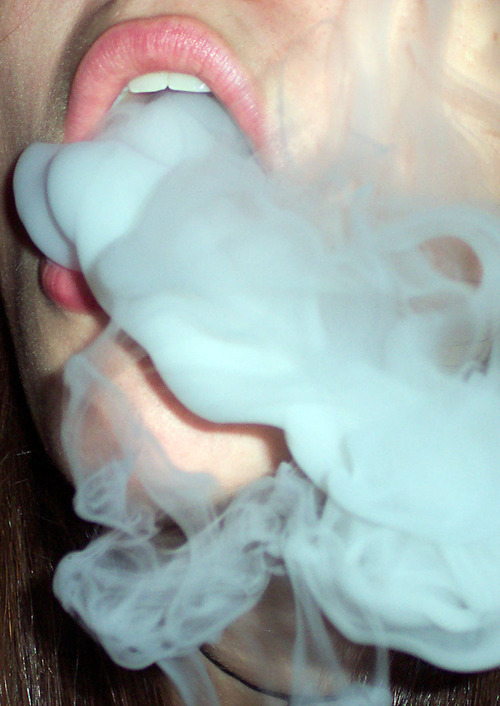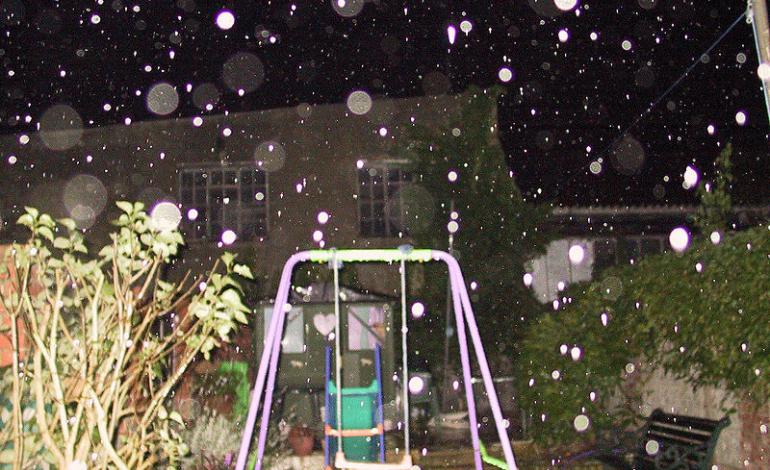Friday, August 21, 2015
Monday, July 13, 2015
Wednesday, July 8, 2015
Thursday, July 2, 2015
Monday, June 29, 2015
Thursday, June 18, 2015
Wednesday, June 17, 2015
Thursday, June 11, 2015
Wednesday, June 10, 2015
Saturday, June 6, 2015
Friday, June 5, 2015
Wednesday, June 3, 2015
Monday, June 1, 2015
Sunday, May 24, 2015
Thursday, May 21, 2015
What's Outside the Range of Human Hearing?
Research indicates that most spirit communications are above the range of human hearing, and only become audible upon significantly lowering the pitch (between 20% - 30% pitch reduction) of the recorded audio. Sometimes part of a complete sentence is outside the range of hearing, and only one or two word responses are heard or captured. When selecting portions of the audio where communication is presumed to be absent, and reducing pitch, the missing portions of the communication become audible. This is why recording the audio for editing before playback is essential during paranormal research. Furthermore, the evidence suggests, when we hear one or two word responses when using a spirit box or similar device, and erroneously assume it is the complete communication, it is due to the limited range of human hearing. Research in this area is continuing, and changing the way we analyze the data.
Monday, May 18, 2015
Friday, May 1, 2015
Monday, April 27, 2015
Sunday, April 26, 2015
Tuesday, April 21, 2015
Wednesday, April 15, 2015
Tuesday, April 14, 2015
Friday, April 3, 2015
Thursday, March 26, 2015
Wednesday, March 25, 2015
Sunday, March 15, 2015
Saturday, March 7, 2015
Thursday, March 5, 2015
Monday, March 2, 2015
Sunday, February 15, 2015
Friday, February 13, 2015
Wednesday, February 11, 2015
Friday, February 6, 2015
Wednesday, February 4, 2015
Afterlife Experiences: Imagination or Something More?
Imagine the moment where you separate from your physical body and become aware of the separation. You might envision bright lights, a tunnel, or the typical near death experience described by so many. Whether the moment is terrifying or blissful might not be of choice with this inevitable occurrence. We all can expect to have this experience at least once in our life, and it will usually occur at the final stage of our physical existence; however, rare cases have been documented where people report having out of body experiences such as this which are not associated with an injury, surgery, death, or any physical trauma. A recent article in Express, an online news journal, covered the story of a woman claiming to have a condition where she experiences about three episodes every month, taking her into the afterlife and bringing her back to face days of fatigue. Her running tally of experiences have totaled more than 1,000 times in her lifetime. Is it imagination or something more? What do you think?
Friday, January 30, 2015
Thursday, January 29, 2015
Hiding Secrets: the Area 51 conspiracy
The government claims time and time again that Area 51 is a test and research site for the United States government's military craft, in an effort to eliminate theories of UFOs and government cover-ups. This type of secrecy over our war planes and weapons is probably a necessary strategy for military operations, but the unavoidable curiosity sparks interest and doubt on many levels. Does anyone really trust their government? This question might point to one of the most relevant issues when it comes to these types of conspiracy theories; however, leaked secrets and personal accounts continually surface, giving value to these theories. The following documentary takes a closer look.
Tuesday, January 27, 2015
Sound Waves I Needed to Hear
The first time I turned on my spirit box and electronic voice recorder, and started asking questions into the air, I wasn't sure if I would get a response of anything more than static and radio interference. I watched all these sessions on YouTube and was struck with curiosity and the needing to know whether there are people, spirits, beings, God, and/or anything beyond my reality. I always believed in God, but nothing seemed as real as it does now. I needed a testimony. I needed their responses as a confirmation. I had a million questions that needed to be answered.
My heart melted and tears filled my eyes with each voice and each word that poured through my headphones. I was constantly overwhelmed with emotion, as I analyzed and edited the audio to find a relevant word or phrase from a conscious being beyond the physical world. It never seemed to get old. Each session evoked the same sense of amazement and emotion. I am not sure whether I was sad and heartbroken they had journeyed on from the physical Earth or whether I was so happy to have made contact with them. Maybe I was both.
Each new session became a mission to learn as much as I could about their existence, the existence of God, and the existence of humankind. I would sit with a list of questions, hoping to receive all the answers. They were always kind, and always answered. I began to notice familiar and regular voices at times.
In my journey to discover existence beyond my reality, I awakened to my own existence and the connection we all have with one another. I connected with kind beings that were willing to share their thoughts, feelings, and the answers to every single question I presented. In this journey, they became my friends. We can all learn so much about each other with an open mind, a kind heart, and the patience to work through the communication hurdles. This is true for this physical life, our contact with the spiritual realm, and our next completion as well. I find myself understanding things just a little more.
Sometimes a comment still brings a tear to my eye, but I smile now more than anything. It has become easier to just have conversation and ask how they are doing. We all change to our true form. We are still ourselves, and our same consciousness with the same personalities. Our existence and every form, from the physical to the spiritual, is something to be celebrated. With great respect and compassion, my research and learning continues. Each new session brings answers, friendships, and smiles.
God bless beings and creatures from this Earth, in the spirit world, and within all the layers and dimensions of existence. I pray God is with us all. And I praise god with worship and thanks for his grand creations.

Sunday, January 25, 2015
Wednesday, January 21, 2015
Monday, January 19, 2015
Sunday, January 18, 2015
Saturday, January 17, 2015
Friday, January 16, 2015
Wednesday, January 14, 2015
Meditation nurtures understanding like water nurtures a flower
Psalms 49:3
My mouth shall speak of wisdom; and the meditation of my heart shall be of understanding.
Knowledge and Wisdom grow from Meditation
FOX News: 10 most sacred spots on Earth
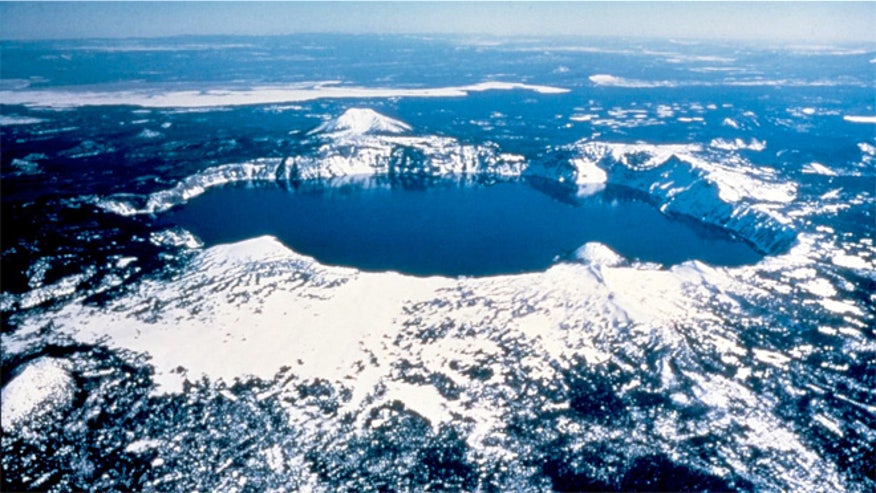
When we modern folks visit a beautiful natural site, the experience may evoke a sense of peace, a feeling of awe...or just the need to snap a million photos. For our ancient forbearers, though, these places were so much more.
Throughout history, civilizations all over the globe have attached spiritual or religious importance to natural spots that played key roles in their respective cultures. From the mythological homes of powerhouse gods like Zeus and Shiva to the serene spot where the mortal Buddha achieved enlightenment, these are the places of legends. Some are still used for age-old rituals, others have been lost to time, but all crackle with a special energy and, if you're lucky, just a little bit of leftover magic.
Uluru-Kata Tjuta, Australia
Located in Australia's Red Centre, in the heart of the continent, these two natural rock formations are the main attractions in the World Heritage Site Uluru-Kata Tjuta National Park. One of the country's more recognizable landmarks, Uluru is a flat-topped sandstone rock standing about 1,100 feet high and almost six miles around, with a soulful, deep-red hue that changes throughout the day. (The site is also known as Ayers Rock, so named by the colonial surveyor who "rediscovered" the place in 1873.) About 30 miles away, Kata Tjuta (a.k.a. The Olgas) is made of more than 30 domes of varying rock types, including granite, sandstone, and basalt; the tallest point is almost 1,800 feet high. Both sites are sacred to the Anangu people of the Pitjantjatjara Aboriginal tribe, who believe the rocks were built during the ancient creation period and are still inhabited by ancestor spirits. (Archeologist work suggests there were humans in this area over 20,000 years ago.) Owned by the Anangu and leased by the government, the park is open to the public, though tribespeople continue to perform rituals and ceremonies in various locations, such as the sacred "Dreamtime" track that runs near the modern hiking trail. The park also houses a Cultural Center (environment.gov.au/parks/uluru) and Aboriginal rock art sites, and ranger guided tours are available.
Getting There: Visitors can drive or join a bus tour to the park from Alice Springs (280 miles away), or fly to Ayers Rock Airport/Connellan (AYQ); Qantas and Virgin Australia offer direct flights from several major domestic cities. There are only a few accommodation choices in the area, in different price ranges, and all are owned by Voyages Indigenous Tourism (voyages.com.au). (Camping is not allowed in the park.) Note that while hiking Uluru is not technically forbidden, the Anangu ask that visitors not climb the rock out of respect for its significance, and also ask that photos not be taken of certain sacred sites. Guests should also not pocket any rocks as souvenirs-those who have say it brings bad luck, and often mail the rocks back to the park. Admission is $26 for a three-day pass.
Cenote Sagrado, Mexico
The ancient Maya revered water for its life-sustaining power, and worshiped Chac, the god of rain, because of this awe of H20. Many areas of Mexico are dotted with cenotes-natural underground sinkholes-and the Maya believed that some of these sites were visited by Chac himself. As a result, somecenoteswere designated as "sacred" and kept for rituals, offerings and sacrifices, while others were set aside for bathing, drinking and crop water. One of the most notable of the sacred springs is Cenote Sagrado, located near the major Mayan archeological site Chichen Itza in the Yucatan Peninsula. Created from a natural limestone cave, with steep sides stretching about 60 feet above the water line, this cenote was specifically used for ceremonies and occasional sacrifices; for the latter, men, women, and children were thrown in during drought times to appease the water gods. When archeologists dredged the spring in the 20th century, they found gold bells, masks, cups, rings, jade pieces, and more (many from the post-Spanish period) along with human bones.
Getting There: One of the most visited archeological sites in Mexico, Chichen Itza can be reached by car or organized bus tours (typically about $35 per person) from nearby tourist hubs like Cancun or Cozumel, or via infrequent public bus service; the ride is about two-and-a-half hours from Cancun. The entry fee is $9 and includes the evening light and sound show; headphone tours are $2. Cenote Sagrado is part of the Great North Platform section of the site (chichenitza.com).
Mahabodhi Tree, Bodh Gaya, India
According to Buddhist traditions, around 500 B.C., when the ascetic Prince Siddhartha was wandering through what's now the state of Bihar in India, he took rest under a native bodhi tree. After meditating there for three nights, the prince awoke with enlightenment, insight and the answers he had been seeking, which developed into the teachings he went on to spread to his disciples. Naturally, the place where the Buddha reached enlightenment is one of the most sacred sites for Buddhists, and has been a major pilgrimage destination for centuries. Today, a temple complex surrounds what is believed to be a direct descendant of the original majestic tree itself, which sits in the middle of a courtyard surrounded by protective carved panels. A beautiful Buddha statue under the tree marks the significant spot.
Getting There: A UNESCO World Heritage Site, the Mahabodhi Temple Complex is in the Bodh Gaya area of Bihar, India. The site is about three miles from the Gaya Airport and about seven miles from Gaya City. Car service, public buses, and bus tours are also available from the holy city of Varanasi; public buses run about $8 (mahabodhi.com).
Mount Kailas, Tibet
This black rock mountain in western Tibet is something of a holy hat trick, since it is sacred to Buddhists, Hindus, and Jains and is thought to be the mythical Axis Mundi, the center of the universe. Hindus believe it is the residence of Lord Shiva and the land of eternal bliss, and have celebrated the mythical Kailas in temple carvings throughout India. Tantric Buddhists say the mountain is the home of Buddha Demchog, who represents supreme bliss, and that three key Bodhisattvas live in the surrounding hills, while Jains believe it is the site (which they call Mount Ashtapada) where the first Jain attained nirvana. The peak is part of the Gangdise Mountain range and is set near the source of some of the longest rivers in Asia, including the Sutlej, the Indus, and the Ghaghara (a tributary of the holy Ganges River). Nearby Lake Manasarovar, considered the source of purity, is another major pilgrimage site for both Hindus and Buddhists.
Getting There: Despite being such a mythical sacred site, Mount Kailas is also one of the least visited, due to its remote location in the Tibetan Himalayas. From Lhasa, it's about a four-night journey over the plateau to the small pilgrim outpost, where there are a few basic guesthouses. From this base, most pilgrims set out on foot, pony, or yak to circumnavigate the base of the mountain, a journey of about 32 miles. There is no record of anyone having attempted to climb Mount Kailas.
Mount Sinai, Egypt
Some of the basic tenets of Judeo-Christian beliefs can be traced back to this mountain on Egypt's Sinai Peninsula, for it was at the top of this peak that Moses is said to have received the Ten Commandments from God. Though there is not much archeological evidence confirming this as the exact place, and biblical scholars have theorized for years about the mythical mountain's location, early Christian monks believed this was the sacred site and established several monasteries in the area. Today, visitors can start at St. Catherine's Monastery at the base of the mountain, then climb to the summit, where there is the small Holy Trinity chapel and stunning views, especially at sunrise.
Getting There: The mountain can only be reached by road; Dahab and Nuweiba are both about two hours away by car, while it's about three hours from resort hub Sharm al-Sheikh. Most hotels on the peninsula can set you up on a bus tour, and many of these arrive at the base around 1 a.m., so visitors can be at the summit for sunrise. There are two ways to climb: by foot (which takes between 45 minutes and three hours, depending on your pace, or by camel, which is about three hours; note that if you choose the latter, you will still have to walk the final 750 steps up to the top. Guests are required to hire a local guide at the entrance for about $15 (the rate is negotiable.) Because of its peaceful silence, the mountain is also popular with visitors who practice yoga and meditation.
Orbs: a load of balls
At last definitive evidence that orbs are not paranormal
Recent developments in digital camera technology has finally permitted an experiment to be undertaken that demonstrates conclusively that airborne material located close to the camera & reflecting the camera flash is responsible for creating Orbs.
The evolution of digital imaging which began in the late 1990’s resulted in a revolution within paranormal research. Investigators began to report a phenomena previously virtually unseen on images taken using conventional film based cameras. By common consent this seemingly paranormal phenomenon was christened the ‘Orb’. Orbs are generally bright circular anomalies within an image, although other shapes such as angular & elongated forms are also found. They may appear as single or multiple anomalies & may also vary both in colour & intensity.
To date, tens of thousands of orb pictures have been offered forward by amateur paranormal investigators & lay members of the public as evidence & proof of something truly paranormal being captured by the camera. The orb debate has blighted paranormal research for (too) many years now with both the believers & the non believers each putting their respective arguments &presenting their evidence.Proffered explanations as to what orbs actually represent vary widely; e.g. many investigators believe they are evidence of, & for, ghost & spirit manifestations. Others consider orbs to be the energetic emissions of angelic & otherworldly beings. The internet is filled with pictures containing orbs presented by paranormal investigators as evidence of some type of ghostly manifestation. Newspapers & magazines regularly publish pictures of orbs, repeating the claims for paranormality occasionally adding a celebrity endorsement just for good measure as in the case of TV star Noel Edmonds. In September 2008, he claimed that his deceased parents “Are melon sized orbs” which he described as being “Little bundles of positive energy” & went on to state that “Conventional photography can’t pick them up but digital cameras can [http://www.dailymail.co.uk/tvshowbiz/article-1055732/My-dead-parents-melon-sized-orbs-New-Age-Noel-Edmonds-bizarre-air-rant.html ]. There have also been a number of books written describing the supernatural nature of orbs &how by interacting with orbs one, can gain spiritual enlightenment i.e. ‘Ascension Through Orbs’ [Diana Cooper &Kathy Crosswell, Findhorn Press].
Many paranormal investigators now prefer to try & steer a middle ground through the orb problem – accepting that dust, flying insects, water vapour &other airborne particles are the likely cause of most orbs they find on their digital pictures & acknowledging the likelihood that the majority of orbs can be explained. All too often, they then go on to state that there remains a number of orbs - a figure of around 1% or 2% is usually favoured; that cannot be explained & so must therefore be paranormal. This small percentage is usually to be found on pictures they have taken! I also wonder how they achieve their statistical probability.
Para.Science has observed & recorded orbs over the past 14 years and have extensively studied the phenomenon in order to try to understand exactly what it is that they represent. Are they the ghostly forms of the dead revealed with the help of modern technology or are they something much more mundane but nonetheless intriguing. Our discoveries are revealed here & we hope that as a result of our own and others careful research and good experimentation it is now possible to solve the riddle & mystique that surround this frequently observed anomaly.
In The Beginning....
First a little history [plus some techie talk too!]. Although developed earlier the first commercial digital cameras started to appear in large numbers during the second half of the 1990’s. They were expensive and of poor quality compared to their modern counterparts or even the cheapest 35mm compact ‘point and shoot’ cameras of that time. Around the same time, digital imaging technology allowed the production of smaller, lighter & cheaper video cameras & soon these too began to hit the high street stores in large numbers, with a feature straight out of Operation Desert Storm - night vision or Nightshot® as Sony preferred to call it. This gave camcorders & one or two still cameras the ability to see & record pictures in complete darkness. The reason for both these technical breakthroughs was the same, the imaging chip that they both used - the Charge Coupled Device or CCD.
The CCD was developed originally for use in Astronomical telescopes and spy satellites and uses the principle of many individual light sensitive photodiodes built into a silicon matrix, each photodiode or pixel producing an electrical charge when it is exposed to light. Small & relatively simple to manufacture the CCD allowed the production of affordable consumer devices to be mass produced. Another form of silicon chip imaging device - the CMOS (Complementary Metal Oxide Semiconductor) chip is also used for the same purposes. Although the CMOS chip uses a slightly different approach to image production, for the purposes of this discussion will be treated the same as the CCD.
To all intents & purposes a digital still camera is in reality nothing more than a video camera that captures single images to its memory instead of a continuous stream of information to a tape, hard drive or memory card. Although the imaging chips were capable of producing excellent quality video pictures their use in still cameras was greatly restricted at first by the small amount of image information that the early devices were capable of registering simply because of their small size, typically around a 1/3rd of an inch across. For a good quality TV picture the picture resolution does not need to be much above 240 lines of horizontal resolution to produce a perfectly watchable picture - this is the resolution of standard VHS videotape. In a still image this level of detail would produce a fuzzy & poorly resolved image that most people would reject as unsuitable, comparative to a computer webcam today. The resolution could only be improved by making imaging chips with more pixels and that meant an either an increase in the physical size of the chip itself with a corresponding increase in production costs or developments to the chip design. However, as with all consumer electronics, technological developments quickly allowed small high resolution image chips to become affordable for all and today we have still cameras with between 5 and 36 million pixels in a silicon matrix often smaller than the size of a postage stamp. Professional digital cameras currently have up to 36 million pixels. That may sound a lot and it certainly offers fantastic picture quality but to put it into perspective such hi resolution just about matches what is capable with the much older 35mm film technology.
Digital photography & video also had some other problems that needed to be resolved before commercial digital photography and video became a viable proposition. One of these was the way the imaging chips respond to light. They were for example much more sensitive to Infra-Red [IR] light & this could result in strange colour casts on the photographs, nobody would be happy if Auntie Nellie had purple hair - unless of course Auntie was an ageing Punk Rocker. Special electronic & optical filtering was required to remove this colour abnormality but one day to the eternal joy of the paranormal investigator Sony launched a range of domestic video & still cameras that allowed this IR filtering to be turned off by the user, allowing the camera to see in apparent total darkness (additional IR lighting is needed, but this is invisible to the human eye). The CCD can also be made to perform in very low levels of ambient light using electronic amplification circuits & although the resultant images were grainy, the simple addition of a pair of IR LED’s (Light Emitting Diodes) below the lens meant that recently generations of innocent badgers could now be spied upon without them ever knowing! Shortly after the first Nightshot Camcorders hit the shops in the late 1990’s the headlines of the Daily Blurb were filled with horror stories of these new camcorders ability to ‘see through’ clothing - a neat trick that only required a cheap filter over the camera’s lens. But before anyone rushes out to buy one, it must be pointed out that all camcorders made since 1996 have lost this ability & also the cost of the filters has shot through the roof! Besides, that particular feature was never that good anyway…. Paranormal Investigators also realised that at last they too could capture moving images in the dark - which is of course where ghosts perform at their best! Early night vision camcorders cost more than £1,000, recent models now start at less than £300 and other manufacturers have either licensed the technology from Sony or found their own ways to allow their camcorders to also see in the dark. Some of these other methods are more effective than others & today Sony still has the best consumer night vision facility of all the various manufacturers. Indeed, this ability is good enough to ensure it used by many TV programme makers. It is worth adding at this point that since 2010, Sony have removed the nightshot® facility from almost every camcorder model except one or two costing well over £1,000 so it is now only possible for poor Ghosthunters to equip themselves with cheaper night vision models by hunting down used examples on eBay.
The digital still camera has also taken off with sales now vastly outstripping conventional film. Virtually all are small & straightforward to use. With a few exceptions they are more closely related to the earlier 35mm point and shoot compact camera in their range of functions and capabilities. These new digital cameras allow just about everyone to take a picture & with a home PC produce a decent set of holiday snaps instantly - in fact nowadays you don’t even need a PC, printing direct from the camera is available on every high street. With its inbuilt flash & complex software taking care of everything, all you have to worry about these days is to keep from cutting off Auntie Nellie’s head at the risk of losing her fashionable Purple Rinse!
The Early Orbs
Para.Science were probably not the first to discover the orb anomaly that was about to burst upon an unsuspecting paranormal world, but as early adopters of digital cameras & night vision video we had come across them before they became the latest craze. During 1998, as part of a long-term investigation at Ellesmere Port’s Boat Museum, we took a series of pictures using an 800,000 pixel digital camera that stored the pictures onto a removable floppy disc. The pictures were taken in the dark using flash & later, when viewing the images we noticed something unexpected & not seen before. A number of circular light anomalies could be seen. In a sequence of three pictures taken over 10 seconds one of these light anomalies appeared to have travelled an estimated distance of more than 20ft - to say we were impressed would be about right! During the course of that night and previously, more than 200 digital stills had been taken at the same location, but only a handful showed these balls of light.
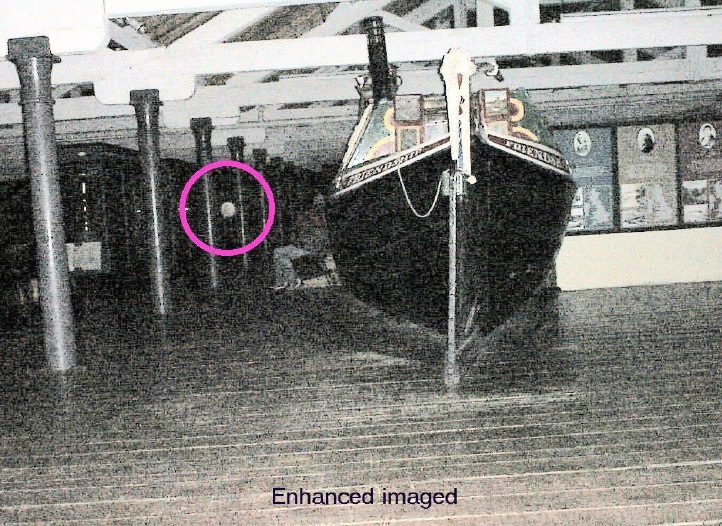
The pictures were enhanced & examined using software developed & written for us, the software permitted us to undertake some basic but meaningful image analysis. The results showed that the light anomalies were not the result of any camera or imaging faults The pictures and a full description of the events were sent to Sony UK for their comments & they confirmed that the camera was not at fault - these ‘Lightballs’ as we christened them, could not be easily explained. A few weeks later, at a different location in an old school we came across a similar phenomenon - close to where many witnesses had reported a ghostly figure. A number of digital pictures were once again taken. Again, we discovered ‘Lightballs’ on some of the digital pictures - this time we were using our newly acquired Fujifilm 1 million pixel [mega pixel] camera. This time too, we also had a night vision camcorder positioned to observe the same area. Playing back the videotape revealed a moving ball of light that quickly moved into the frame. The ‘Lightball’ appeared to stop, then change direction rapidly before exiting the bottom of the frame.

These separate items of equipment had apparently recorded the same event & at around the same time. After careful scrutiny we felt we had compelling evidence for something very unusual taking place & beyond all our attempts at a reasonable explanation at that time. We placed the pictures & video stills online whilst we continued to try and devise some experiments to understand what we were seeing. A group in the USA using nearly identical equipment contacted us, they also had pictures of these ‘Lightballs’ but no video footage at that time. It seemed a good idea for both groups to work together on trying to discover more about this phenomenon. They also found that sometimes high EMF levels were present coincident with the Lightballs and later on they also had a lot of success capturing the balls of light on night vision video. Over the next few months we shared regular email correspondence with them & we jointly set about devising various means of discovering more about these light anomalies. Some statistical studies were carried using the internet to speed up the information gathering process. We hoped to determine just how likely a camera was to produce a ‘Lightball’ in a picture. Many hours were spent studying the ‘Lightballs’ with our image software, measuring them, looking at the colour, the colour temperature, the density; in fact anything we could think of to try & learn anything we could about them. One of the things we did discover is that the ‘Lightballs’ seemed to be reflective; they gave off light with characteristics very similar to either the flash light on the camera or in the IR part of the spectrum - around 680nm that was used by the IR LED’s to illuminate the scene in front of the camcorder. If the ‘Lightballs’ had emitted their own illumination we should have expected that it should be of a different colour or colour temperature to the light emitted by the camera. As the months passed, more & more paranormal investigators and groups started to use digital cameras and night vision videos in support of their own investigations. We noticed that other groups were also finding these ‘Lightballs’ in fact they were becoming almost a common occurrence. They gained a new name too - from the USA where groups had started to refer to them as ‘Orbs’. As the number of Orbs went up - the number of theories about what they could be abounded on the Internet. Many believed that they were direct evidence for ghostly manifestations, the first stage of the appearance of a ghost. Some thought them to be a visualisation of Poltergeist activity. Others believed them to be Angels & claimed they could even tell the sex of them by looking at the colour of the Orb - naturally, Pink for a Girl and blue for a Boy! Faces were seen in the Orbs and they were said to often move about in a controlled and intelligent way responding to the investigators requests for them to perform!
With so many orbs by now being reported we were still undecided about their true nature - they were certainly intriguing but by now they were just too commonly reported & that disturbed us greatly. Surely, if they were paranormal, then how could they be so common? Was the digital imaging chip - the device that lead to development of the digital camera & night vision video, the breakthrough tool that paranormal investigators had longed for? Just about everyone with a digital camera were capturing orbs. They appeared in haunted locations, they appeared in non-haunted locations, they appeared both indoors and outside, there was something terribly wrong - this surely couldn’t be paranormal, there were just too many Orbs out there!
From 1999 – 2003, Para.Science undertook a further series of studies to determine the nature of orbs & also why they appear on digital cameras. Just how many orbs? We decided to try & determine just how likely a digital camera was to capture an orb & after some thought a simple experiment was devised. We would also try to establish if any particular make and model were more or less likely to capture an orb. Using the Internet, we obtained more than 1,000 digital pictures from each of the major digital camera makers i.e. Sony, Nikon, Kodak, Fuji etc. This was easy given that makers had a different file naming protocol for their camera pictures such as MVC123.jpg for Sony for example. The digital file data - the EXIF file also allowed us to see the camera settings i.e. shutter speed & aperture & also if flash had been used. A straightforward but time consuming affair, within a month & after downloading more than 10,000 pictures we had the first results. We found that orbs appeared almost at random in every sort of location - most of which never had any association with the paranormal or had to our knowledge ever been reported as haunted. The vast majority of the orbs did not even warrant a mention by the picture takers, either going unnoticed or ignored. The results showed that those with a Fuji or Kodak camera had the greatest chance of producing an orb - almost 20% of the pictures taken using flash with these makes showing an orb. Those using a Canon or Nikon model stood around a 1 in 20 chance of an Orb appearing in the final picture. Orbs only ever appeared in pictures taken using the flash &we found none in those taken without flash. Later, this experiment was repeated with a larger sample (n=21,000) & taking into consideration the exact model of the camera, the results were again quite clear. Overall, the cheaper the model of camera, irrespective of manufacturer, the more likely it was an orb would be captured. Likewise, the physically smaller the camera, the more likely it would be to photograph an orb; irrespective of its cost. However, because Orbs were so common we had to face an unusual possibility - if orbs were indeed the first stage of a ghostly manifestation then perhaps ghosts or spirits were a very common phenomenon, that up until now we just had been unable to detect without digital technology. Again, we extended our Internet based study to see if we could discover just how often orbs were being reported in association with haunted locations. This time we only looked at pictures containing orbs - more than 5,000 of them but it was quickly clear that they were just as likely to appear in a non haunted location as a haunted one. It was starting to look suspiciously like orbs were nothing more than the camera seeing something normal but in an unusual way. Already, some people had suggested dust or insects as a possible culprit of the orbs.
Others were also beginning to question the orb phenomenon - a small number of experimenters (i.e. ASSAP) had thrown & blown dust or powder in front of cameras with convincing results. We ourselves conducted similar experiments with flour, talc or other small particles. When caught in the flash they produced convincing orbs that looked exactly like those seen in many of the pictures we had looked at & taken ourselves on investigations. Outdoors, in even slightly misty conditions a flash picture could produce tens or even hundreds of orbs, although Rain produced a smaller number of orbs per picture. The experiments also produced some unexpected results; often a large quantity of powder was thrown in front of the camera as the flash was fired & a picture taken, but on the resultant picture only one or two orbs would be seen. When taking pictures of almost invisible mist the picture would be filled with dozens of orbs. We were expecting the opposite case to be true - a large amount of dust or powder should produce a lot of orbs &a few sparse water droplets should produce fewer orbs.
A series of emails to a University optical lab later & we had the answers we needed &a satisfactory explanation to this particular conundrum. Dust particles are not very reflective so few of the dust particles will reflect the light from the camera’s flash back toward the image chip. Water droplets are however like minute spherical mirrors & like cats eyes in the road many more will reflect the flash burst back to the camera. The range of the flash & the angle between the particle or droplet &the lens also affected the number of orbs that were produced. To make the best orbs the particles / droplets should be physically very close to the camera where the lighting is the strongest &also they should be within 15 degrees or so of the lens’s central axis. This clearly demonstrated why the number of orbs seen in a picture often bore little relationship to the actual amount of dust particles or water vapour droplets in the air. We also wrote to several camera manufacturers & also to the makers of the imaging chips. We discovered that the way a digital device sees the world is very different from the way we see it or a film camera sees it. We already knew about the IR sensitivity of the digital chip & we also discovered that they are more slightly sensitive to UV light too. All image chips rely on software to actually construct the image from the millions of individual pixels & in consumer cameras the software is required to compress the raw data in order to get enough pictures onto the storage media or memory. The compression ratio &also the software compression algorithms varied not only from different makers but frequently even across a camera maker’s own range of products.
As an example a typical 5 megapixel chip actually captures around 10% of the total image information available within a scene when compared with a 35mm camera negative. The software is required to fill in the gaps in the image by making comparisons with the information from neighbouring pixels, a process called interpolation. Thus a single pin point of light within a scene may either be ignored completely, or seen & then expanded by the software as it compares &interpolates each pixel with its neighbours; the single point source of light becoming a gradually larger &fainter circle of light. This can produce the characteristic circular orb anomaly. The image chip also has a further trick to play on the unsuspecting ghost hunter; sometimes individual photodiodes may not respond correctly to the light falling on them, resulting in it sending a signal that is either 100% on or 100% off. Again, the software would interpolate these white specs into circular orbs - Black orbs, caused by the 100% off-state of a pixel are also seen, but more rarely as they tend to blend into the background of the image more readily. The mechanisms that caused orbs to appear on digital pictures also applied to those being seen on the night vision video footage. This time the cause was the Infra Red LED’s mounted just beneath the lens on every model. These acted exactly like mini headlights, sending an IR beam out in front of the camcorder. One attempt to try to capture video orbs to order took place whilst filming a documentary on ghosts for a Japanese TV company. In one particular room we could see a literal blizzard of dust orbs moving past the IR CCTV camera as we watched from the control room on a monitor. We set off armed with a night vision camcorder &two-way radio to try &capture them for ourselves. The controller talked us into the orbs as he watched them on his screen. We hunted for some time in vain for the orbs he could see. It seemed like our theory that orbs were dust was falling in tatters around us, we moved closer &closer to the actual CCTV camera that was seeing them. When we got less than a foot away from it we found our prey - the orbs were there in quantity but could only be seen close to the CCTV camera because its IR LED’s surrounding the lens were not very powerful &were not capable of lighting up the dust particles more than a few centimetres away. Our own failure to see them was also compounded by us using a more powerful IR light, but one that was mounted high above the camcorder on an extension bracket thus taking the light further away from the lens axis &thus preventing reflected light bouncing back into the lens. Later when we removed this light & went back to only using the pair of IR LED’s below the lens of the camcorder, we saw orbs a plenty! The moving orbs seen on the night vision video were simply the result of the camcorder capturing a moving image of the dust or water droplets as they get carried past on the slight currents of moving air that are always present within a building. Another interesting type of orbs could be seen to sparkle or flash as they passed through the picture. Again the answer was straightforward, these particles were simply of a more facetted shape & as they spun & tumbled in the air currents, different surfaces reflected the light back to the camera with more or less intensity. These early study strongly suggested that in order to produce an orb anomaly within a picture a number of conditions need to be met; i.e. the camera flash must have been used at the time of picture taking, the airborne material must be located within a few centimetres of the camera lens & the airborne material must also be within a narrow range of angles relative to the lens central axis for the material to be able to reflect the light from the flash into the lens. The result of all the studies undertaken by Para.Science & other investigators demonstrated the strong probability that orbs were simply the result of airborne dust, moisture & other particulates reflecting the light from the camera flash back toward the imaging chip, resulting in the characteristic bright anomaly.
So, that we thought, was that! Orbs were nothing more than microscopic dust &water vapour droplets reflecting back the light of the flash that was often too close to the lens axis. Orbs were in fact dust & water suffering with red eye, like those pictures of a Demonic Auntie Nellie with her glowing red eyes & purple hair!
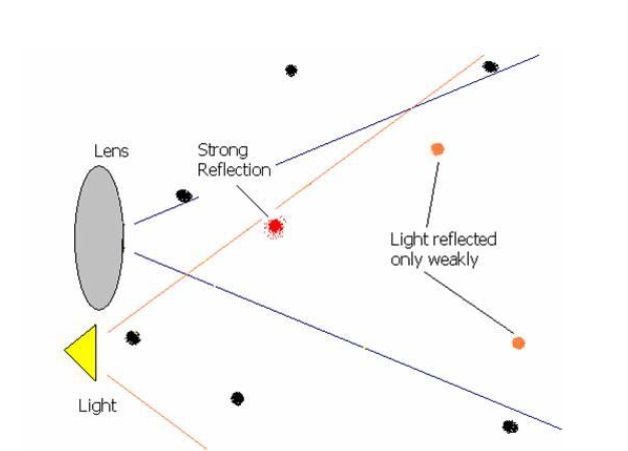
The initial studies by Para.Science together with early experiments by others resulted in many investigators questioning the true nature of orbs & leading to more groups subsequently carrying out their own experiments with the result that the probability that orbs are simply the result of airborne dust & other material has been widely acknowledged. However the inability of any of the foregoing studies to conclusively demonstrate that airborne matter & moisture is responsible for orb production allowed the debate between the orb believers & the orb sceptics to continue, to the obvious detriment to paranormal research & to the continued confusion of all concerned.
An experiment considered some time ago by Para.Science was the use of stereo (left & right) photography to explore the orb phenomena. Using this technique we realised that it should be possible to properly test the hypothesis that orbs are airborne matter, physically close to the taking camera. Thus, if an orb was found to be present on one picture of a stereo pair of pictures taken simultaneously & not present on the other; then the original source of that anomaly must be located within the angle of view formed between the flash & the lens in order that the flash illumination is reflected from the source & causing the characteristic bright anomaly to appear on the final picture. Also, such an object appearing on only one of the stereo pictures must be physically close to the camera as it would appear on both of the stereo pictures if it was located more than a few centimetres from the camera (normally less than 2-3cm). The actual distance being determined by the separation of the two lens axes. Although stereo photography was a well understood technique that has been used with film photography for many decades, the technical difficulties applying it to digital photography & ensuring that the resultant images were identical proved technically & practically insurmountable at that time. Those difficulties included; finding a means of ensuring that both pictures were taken simultaneously, that both pictures had identical photographic settings i.e. focus & exposure & that both pictures had identical post image processing applied i.e. scene pre-sets, colour balance, file compression etc. The use of a stereo lens fitted to a digital camera was also considered, but discounted, as firstly it partially blocked the light from the camera’s built in flash & secondly the use of a single lens / image chip meant that it would not be possible to fully exclude any artefacts & errors caused by either the lens or the image chip, both of which are known possible causes of some orb-like photographic anomalies.
Launched in mid 2009, The Fujifilm W1 3D digital camera was at the time a unique digital camera comprising two separate lenses & two separate high resolution image chips; forming a matched pair of image taking systems integrated within the same camera body. The two image taking systems shared a single common flash positioned equidistant between the two lenses. Crucially, both
matched image taking systems were activated by the same shutter button & used the same focus, exposure & flash settings, thereby ensuring that the two resulting images produced for each press of the shutter were identical in every respect except for the parallax separation between the left & right pictures. This camera has permitted the hypothesis that orbs are the result of nearby airborne matter reflecting the flash light back toward the camera to finally be properly tested. The author was fortunate in being able to secure one of the first examples of this new type of camera shortly after its launch in the autumn of 2009 in order to begin a renewed investigation of the orb phenomenon. Recently several manufacturers have released their own 3D still & video cameras including Panasonic & Sony. Fujifilm have also replaced the W1 with an improved W3 model although the upgrades are largely cosmetic & offer improvements to the camera’s video capabilities.
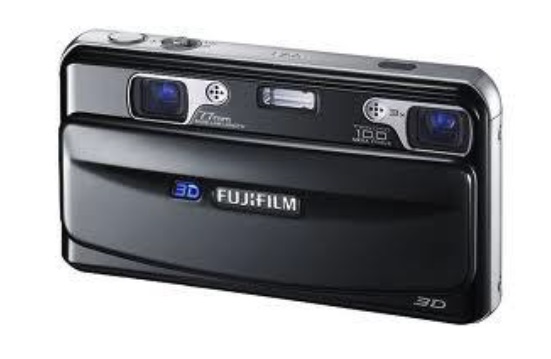
The Fujifilm W1 camera has been used in a series of experiments undertaken at more than twenty locations widely spread throughout the UK & Eire during 2009 & 2010. Locations were selected to encompass a broad representation of allegedly haunted venues e.g. castles, industrial sites, modern retail premises & also included both indoor & outdoor locations. Photographs were taken at some well known locations too, such as Mary King’s Close, Edinburgh; Margam Castle, West Wales; & Wicklow Gaol in Eire to name just a few. In most instances the photography was undertaken whilst paranormal investigators & members of the public, unaware of the particular nature of the camera or the experiment being undertaken conducted some form of paranormal investigation. This lead on one occasion to an amusing incident when a Psychic Medium at one location noticed an ‘orb’ on the LCD screen of the camera & promptly declared the photograph to be ‘Proof’ of the spirit of a young girl who haunted that location!
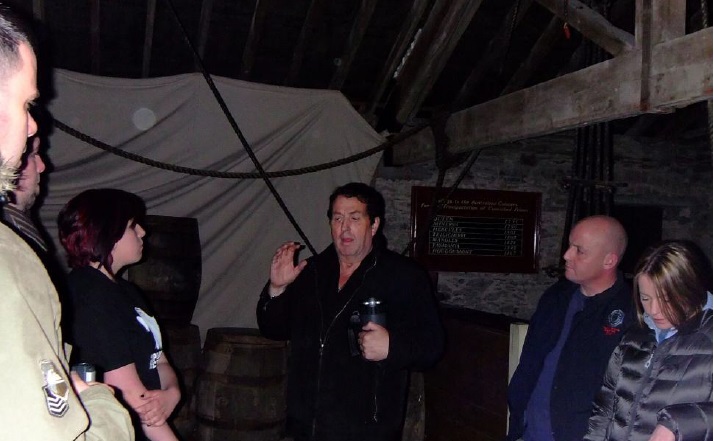
Needless to say, upon examination, the orb was found to present on only one of the stereo pictures & thus another paranormal orb bit the ‘dust’ – obvious pun intended! In order to replicate the ‘point &shoot’ technique of most digital photography undertaken during amateur paranormal investigation the camera was only used in the fully automatic exposure & focus mode. The use of the fully automated mode also ensured that the resultant stereo pair of images were identical in terms of any software processing of the images that is applied in-camera i.e. those affecting the colour balance, scene pre-sets, file compression etc. The stereo paired images were subsequently downloaded from the camera to a laptop computer. No enhancement or manipulation of the resulting images was undertaken. Each simultaneously taken stereo pair of images was then viewed side by side &simply compared visually for the presence of orb anomalies on either one of the pair.
To date 1,870 stereo pairs of images have been taken &examined. Orb anomalies have been found on 630 pairs. In 491 pairs, an orb or orbs was seen to be present in only the left or right image but not in the corresponding second image of the pair. In 139 stereo pairs, orbs were seen to be present in both of the images (left & right) but not in a position that corresponded to the individual orb being the same object.
Shown below are samples of the stereo paired images, showing no corresponding orbs appearing on both left & right pictures.
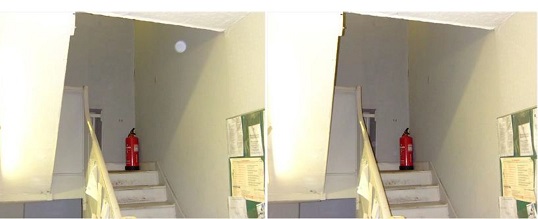
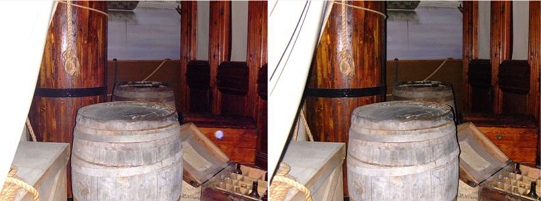
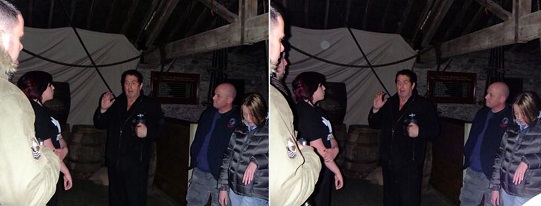
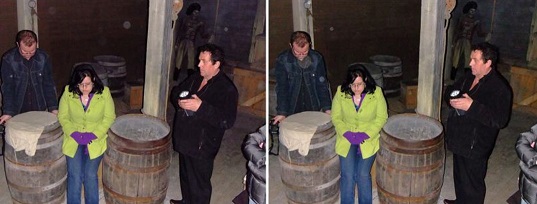
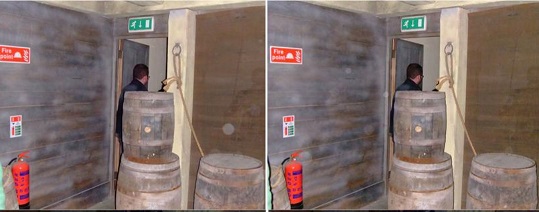
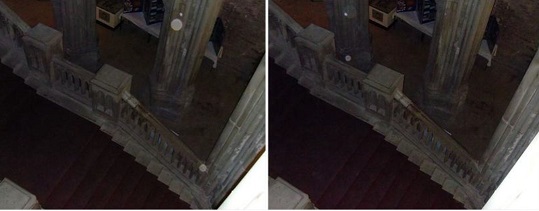
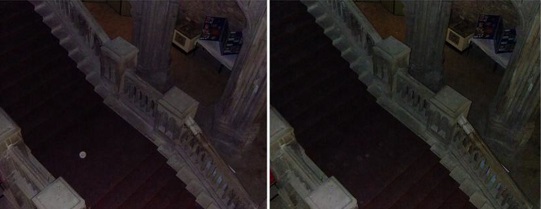
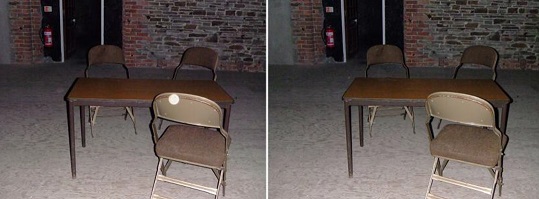
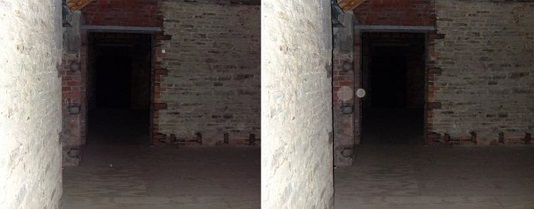
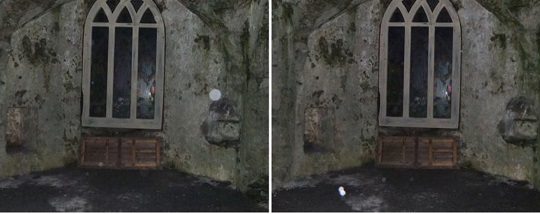
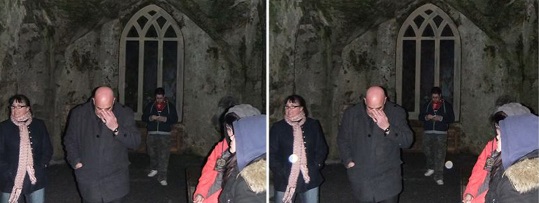
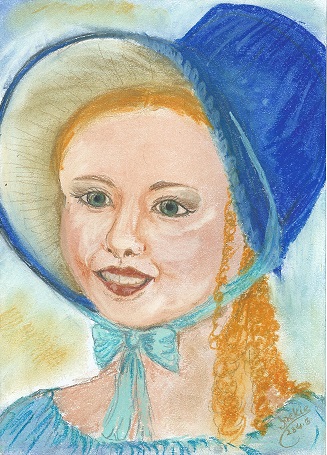
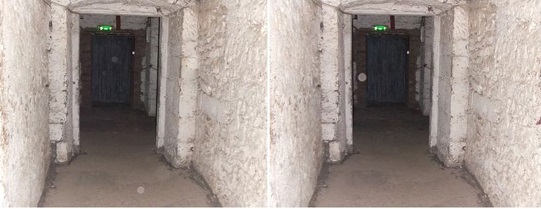
Orbs are Normal
This comprehensive survey strongly supports the hypothesis that orbs are simply the result of dust & other airborne material drifting close to the camera & reflecting the flash illumination back toward the image sensor & provides long overdue definitive evidence that their origin lies firmly within the mundane & explainable, not the paranormal or supernatural.
Interestingly, a further four stereo pairs of images show other anomalies that are frequently offered up as evidence of the paranormal. Two are images of the camera strap; whilst two more show breath condensation as the author exhaled. As with the orb photographs these four anomalies appear on only one side of the stereo pair, again showing that they were quite normal in origin.
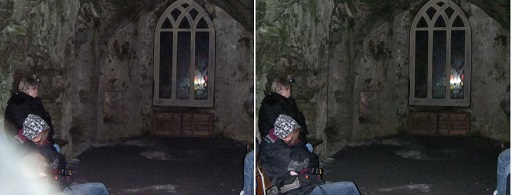
99% of orbs are caused by dust…....
Before concluding it is also worth bearing in mind those original statistical claims that 1% or 2% of all orb pictures represent paranormal orbs. The survey to date has captured over 600 orbs so it might be expected that we should have expected to have found between 6 &12 that were paranormal. We didn’t – all 630 that we obtained in the survey were readily explained using the stereo photography technique. Statistically speaking that is 0% paranormal but 100% explainable.
So at last, it is hoped that this extensive series of pictures will finally remove much of the confusion & nonsense that has surrounded the orb &similar classes of photographic anomaly &permit psychical research to move forward from this long standing debate
Appendix 1.
The Fujifilm FinePix W1
The Fujifilm FinePix W1 Series Real 3D a digital camera designed to capture stereoscopic images that recreate the perception of 3-D depth, having both still &video formats while. The camera uses a matched pair of lenses. The lenses are offset left-to-right by 77mm, a baseline that approximates the distance between an average pair of human eyes. The W1 has two lenses / image CCD systems, each capable capturing images at 10 megapixel resolution &each capable of 3x optical zoom (35mm - 105mm in 35mm camera equivalent). The color LCD display on the rear of the camera measures 2.8” diagonal. It can be electronically switched between normal display &auto-stereoscopic display. In addition to its use as 3D camera the two separate image systems within the camera can also be used to take two simultaneous shots of the same scene with different settings (zoom, ISO, etc.). In December 2010 via the Russian spacecraft Soyuz 25S, a European Space Agency astronaut used a Fujifilm FinePix REAL 3D W1 aboard the International Space Station.
Specifications (Courtesy of Fujifilm UK)
Number of effective pixels 10.0 million pixels
CCD sensor 1/2.3-inch CCD x2
Storage media
Internal memory (Approx. 42MB)
SD memory card
SDHC memory card *2
File format
3D Still image: MPO+JPEG, MPO (Multi Picture Format compatible)
2D Still image: JPEG (Exif Ver 2.2 *3) (Design rule for Camera File system compliant / DPOF-compatible)
3D Movie: 3D-AVI (Stereo AVI format with 2 image channels)
2D Movie: AVI format (Motion JPEG with sound)
Number of recorded pixels L: 4:3 3,648 x 2,736 / L: 3:2 3,648 x 2,432 / M: 4:3 2,592 x 1,944 / S: 4:3 2,048 x 1,536 pixels
Lens Fujinon 3x optical zoom lens, F3.7(W) - F4.2(T)
Lens focal length f=6.3 - 18.9mm, equivalent to 35.0 - 105.0mm on a 35mm camera
Zoom
3D: up to 3.8x (Combined optical and digital zoom)
2D: up to 17.1x (Combined optical 3x zoom and digital 5.7x zoom)
Aperture Wide: F3.7 / F5 / F8, Telephoto: F4.2 / F5.6 / F9
Focus distance (from lens surface) Normal:
Approx. 60cm / 2ft. to infinity Macro (2D only):
Wide: Approx. 8cm - 80cm / 0.3ft. - 2.6ft.
Telephoto: Approx. 60cm - 3m / 2.0ft. - 9.8ft.
Quick AF: Approx. 1m / 3.3ft. to infinity
Sensitivity Auto / Equivalent to 100 / 200 / 400 / 800 / 1600 (Standard Output Sensitivity)
Exposure control TTL 256-zones metering, MULTI, SPOT, AVERAGE
Exposure mode Programmed AE, Aperture Priority AE, Manual
Shooting modes
SP mode: Natural light, Natural light and with Flash, Portrait, Landscape, Sport, Night, Night (Tripod), Sunset, Snow, Beach, Underwater, Party, Anti-Blur
ADV 3D: Interval 3D shooting, Individual shutter 3D shooting
ADV 2D: Tele/Wide simultaneous shooting, 2-Color simultaneous shooting, 2-Sensitivity simultaneous shooting
Shutter speed
Night: 1/8sec. - 1/500sec.
Night (Tripod): 3sec. - 1/500sec.
Manual: 1/2sec. - 1/1000sec.
All other modes including AUTO: 1/4sec. - 1/1000sec.
Continuous shooting
3D: Top-40 (max. 2 frames/sec. “S” only)
2D: Top-40 (max. 1 frame/sec.)
High speed Top-40 (max. 3 frames/sec., “S” only)
Focus
Mode: Single AF
AF mode: 3D: Centre
2D: Centre, Multi (for Face Detection off only)
White balance Automatic scene recognition
Preset: Fine, Shade, Fluorescent light (Daylight), Fluorescent light (Warm white), Fluorescent light (Cool white),
Incandescent light, Underwater lighting
Self-timer Approx. 10sec. / 2sec. delay
Flash Auto flash Effective range: (ISO AUTO):Normal
Wide: Approx. 60cm - 3.7m / 2ft. - 12.1ft.
Telephoto: Approx. 60cm - 3.3m / 2ft. - 10.8ft.
Macro (2D only)
Wide Approx. 30cm - 80cm / 1ft. - 2.6ft.
Telephoto: Approx. 60cm - 1.6m / 2ft. - 5.2ft.
Flash modes
Red-eye removal OFF: Auto, Forced Flash, Suppressed Flash, Slow Synchro.
Red-eye removal ON: Red-eye Reduction Auto,
Red-eye Reduction & Forced Flash, Suppressed Flash, Red-eye Reduction & Slow Synchro.
LCD monitor 2.8-inch, Approx. 230,000 dots color LCD monitor with Light Direction Control, Approx. 100% coverage
Movie recording 640 x 480 pixels / 320 x 240 pixels (30 frames/sec.) with stereo sound * Zoom function cannot be used during movie recording.
Photography functions
3D:Auto parallax control, Power management, Framing guideline, Frame No. memory
2D:Face Detection (with Red-eye removal), Power management, Framing guideline, Frame No. memory
Playback functions
3D:Parallax adjustment, Multi-frame playback (with Micro thumbnail), Cropping, Resize, Sorting by date, Slideshow
2D:Face Detection (with Red-eye removal), Multi-frame playback (with Micro thumbnail), Sorting by date, Cropping, Resize, Slideshow, Image rotate
Video output NTSC / PAL selectable
Digital interface USB 2.0 High-speed
Power supply NP-95 Li-ion battery (included), AC power adapter AC-5VC (included)
Dimensions Approx. 123.6 (W) x 68 (H) x 25.6 (D) mm / 4.9 (W) x 2.7 (H) x 1.0 (D) in. (excluding accessories, battery and memory card)
Weight Approx. 260g / 9.2oz (excluding accessories, batteries and memory)
For further information about the Fujifilm W1 and later W3 3D cameras -
Article & Images copyright Para.Science (except the picture of the Fujifilm FinePixW1, courtesy of Fujifilm, UK.
Article first published at http://www.parascience.org.uk/
Subscribe to:
Posts (Atom)










